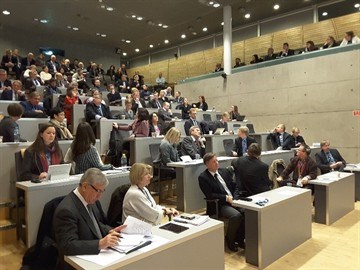NSPA position on the future investments in the European Arctic
In January and February, the Northern Sparsely Populated Areas in collaboration with the European Commission carried out a public consultation about the future EU priorities in the European Arctic.. The NSPA is now presenting the report that summarizes all the proposals that it has received from the northernmost regions of North Sweden, North Norway and East- and North Finland.
The reason for launching a public consultation was the new EU Arctic policy, presented in 2016, that highlights main areas of concern of the European Union in the Arctic. Besides climate issues and international cooperation, the new policy informs on the importance of the sustainable development of the EU's arctic regions. It also defines investment priorities in the European Arctic for next budget period of the EU after 2020. The NSPA that participated in the formation of the new policy was invited to continue the discussions and contribute to it with the regional perspective. It was offered to present its proposal on what the European Union should focus on, regarding future investments in the northernmost regions.
To present a joint proposal on the EU's priorities in the Arctic, the European Commission, in collaboration with the NSPA, launched a consultation with the stakeholders, including the regional actors and indigenous peoples. The consultation was open and every region was strongly encouraged to participate. Thus, the stakeholders from the NSPA-network left their proposals to their regional European Offices, so that they could take it as a joint statement through NSPA to the European Commission for further investigation. At the same time, Iceland, Denmark, the Faroe Islands, Greenland and the Saami Council will hold their preparatory work and conduct separate consultations processes with their stakeholders.
Main questions that stakeholders were offered to reflect upon can basically be summarized to the following:
• What should the EU prioritize, regarding investments in the arctic regions?
• How should EU's funds and programs be designed to promote these investments?
Consultation's outcome
The NSPA compiled all the received proposals in one report under the title "Building strong and smart communities: NSPA proposal for EU investments in the Arctic", that has now been forwarded to the European Commission for further elaboration.
According to the feedback from the NSPA's regions and their stakeholders, in the European Arctic the EU should first and foremost focus on the following areas:
1. Transport infrastructure;
2. Digital infrastructure;
3. Health and well-being for the attractive societies;
4. Education and skills;
5. Innovation support and green solutions;
6. Key industries - Arctic smart specialization.
The NSPA insists that no area should be prioritized more than others, but rather they should be developed in symbiosis with each other in order to strengthen the regions. Moreover, the NSPA points out that many of the proposals are based on the policy recommendations, that the OECD presented in its report "OECD Territorial Reviews: Northern Sparsely Populated Areas".
The NSPA position on the EU programs in Arctic
The other part of the report was dedicated to the strengths and weaknesses of the EU financing programs in the NSPA regions. The NSPA highlighting the importance of the EU funds and programs are of a great importance for the regions because they contribute to the sustainable growth, business development and reduced unemployment. However, at the same time, the report reveals that there are certain challenges that are caused by the complicated regulations of programs implementation. They include, for example, a very high level of bureaucracy and dissimilar application rules, that significantly differ from each other in different NSPA regions, as well as on the national and the EU levels.
In order to be able to overcome these challenges and facilitate a larger participation rate in the EU financing programs among the stakeholders in the European Arctic, the change is needed. Therefore, the NSPA regions have suggested several proposals on how to improve the rules and make EU funding more efficient. One of the proposals is to make cooperation between regions within a program more transparent and well-organized on the preparatory stage. Besides, the NSPA suggests that the EU means should be granted beforehand, so that small and medium-sized enterprises, that have a limited financial capacity, could also participate in the larger number of programs.
The NSPA suggests introducing a cross-sectoral approach when participating in a EU program. For example, if a project is built upon improving the transport system, it can also influence tourism, digitalisation and labour market, which means that the planning of projects should be more inclusive.

Dialogue on the EU investments in the arctic regions in the frames of the Arctic Frontiers conference in Tromsö on the 23rd of January, led by the NSPA with the regional representatives from Sweden, Finland and Norway, together with the EU Commissioner Karmenu Vella, responsible for the Arctic, (in the bottom left corner).
Discussions continue in Oulu on the 15-16th of June
The open discussions will continue on the "High-Level Arctic Stakeholder Forum meeting" conference in Oulu, Finland, on the 15-16th of June 2017. In the frames of the conference the European Commission is also going to present the first preliminary report on the EU's regional priorities in the Arctic, based on the NSPA's contribution. During the conference, there will be a chance to discuss regions' needs that will be used as a foundation for the final rapport, which is to be presented this autumn. Here you can find more information about the conference.
On the 14-15th June 2017, Oulu will also host the 2nd Top of the World Arctic Broadband Summit in parallel with the High-Level Arctic Stakeholder Forum meeting. You can register for the summit here.
